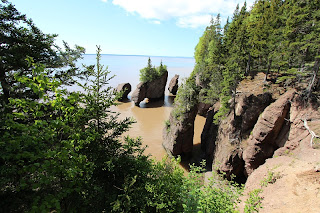I've skipped a couple days of our travels--some of our internet reception has been spotty, and I need to catch up. We moved to Saint John, New Brunswick, from Bangor, Maine on June 2. A small, free government ferry across Grand Bay took us to our campground at Harding's Point. This ferry runs 24 hours, and accommodates enormous tractor-trailer combinations.
Grand Bay Ferry
On June 3 the weather turned to rain and fog and dampened our sight seeing possibilities. We did visit the New Brunswick Museum and Saint John City Market downtown. The museum relates the natural, cultural, and industrial history of the province. An interesting exhibit in the gallery Our Changing Earth displayed rocks keyed to all of the geologic time periods; the Hall of Great Whales held whale and mastodon skeletons. There is an impressive collection of local and international fine and decorative arts, and opportunities for activities for children.
The Saint John City Market is housed in a building constructed like a boat. The museum and market are enclosed and surrounded by a large modern mall and office buildings, attached with sky bridges, so that even on this rainy day, we didn't need to go outdoors. The market vendors sold fresh produce, meat, and fish, and buzzed with people and activity. Fiddlehead ferns are in season, and we bought some to try. Other stalls held jewelry, t-shirts, crafts, and clothing.
We drove to see the famous Reversing Falls (also called Reversing Rapids) not far from downtown. Here the St. John River flows over a falls during low tide; and during high tide the falls is drowned out and the flow is reversed over it. At slack tide, when the water is near high tide and still, there's a window of about 20 minutes that boats can travel from the St. John River into the Bay of Fundy and visa-versa.
Today our rig is parked at the Ponderosa Pines Campground in the town of Hopewell Cape in New Brunswick. We left Saint John yesterday (June 4) and traveled along Highway 1, until we (our friends Marge and Jerry with us) turned south and pulled our rigs through the Fundy National Park on Highway 114. What fabulous scenery on a gorgeous day! We were surrounded on all sides by all textures of trees--straight conifers, bushy birch and alder types, underbrush--all with every shade of green imaginable. We passed near small, well-kept communities with their neat homes and steeples, spread over the hills and fields and down in the valleys. Small herds of dairy cows chewed their cuds, and horses grazed and dozed in the sun.
Highway 1 is smooth, for the greater part, and the grades are gentle. Highway 114, however, was a challenge, being rough with steep ups and downs on its way to the Bay of Fundy. Our old 8.1 liter Silverado with 250,000 miles hung with us and we had no problems. The view from a high viewpoint was stunning! The Bay of Fundy is huge!
Today we visited the Hopewell Rocks and Flower Pots at high tide and later near low tide. The high tides at this location range from 35 to 43 feet, and the Bay of Fundy is know to have the highest tides in the world, at 52 feet in some locations.
Hopewell Rocks at high tide
Hopewell Rocks near low tide
(Note people for scale)
While waiting for the low tide, we visited the Albert County Museum, a couple kilometers up the road. Several restored buildings, including the tax office, records hall, community hall, court house, and gaol (jail) are on the grounds of this museum. The community hall is still in use, and has a curtained stage. On the wall are framed charters for the local Sons of Temperance, 1891, and the Good Knights Templar, 1893.
Many of the original tax records are still in the tax office and visitors can look at the list of liens in a large account book from 1899 to 1928, in neat columns and perfect penmanship. The exhibition hall houses an extensive collection of late 1800's and early 1900's agricultural and trade implements and machinery--some identical to those I used when a teenager in Iowa. For instance, I remember well the hand-cranked corn sheller I used as a farm laborer, and a belt and pulley system was displayed similar to the one my dad used to mix concrete for making blocks and bricks.
The most colorful historical figures associated with this museum are Prime Minister R.B. Bennett and Tom Collins. Bennett was born and educated in Hopewell and served as Prime Minister during the Great Depression years of 1930-35. He instituted many "new deal" programs similar to those put in place by President Roosevelt during the same period. He remains the only prime minister of Canada to come from New Brunswick. He was an ambitious businessman and helped push through innovative programs with the government even before his prime minister tenure. The state of the economy took its toll, however, and he could not escape blame for the appalling conditions during the depression. Bennett hated to leave Canada, but needed to get away from the day-to-day involvement with business and politics, and moved to England for his health, where he died in 1947.
Tom Collins was the famous convicted ax murderer who was hung for his crime on a scaffold next to the courthouse.
This museum with its grounds is neat, well-kept, and very interesting. The push-button movies with characters speaking regarding the history all worked very well. There's also a 20-minute movie shown in the exhibition hall. We are so glad that we stopped to visit this gem.
Tomorrow we will drive west on the Fundy Coastal Drive from here, and explore the town of Alma, then visit the Cape Enrage Lighthouse.




No comments:
Post a Comment